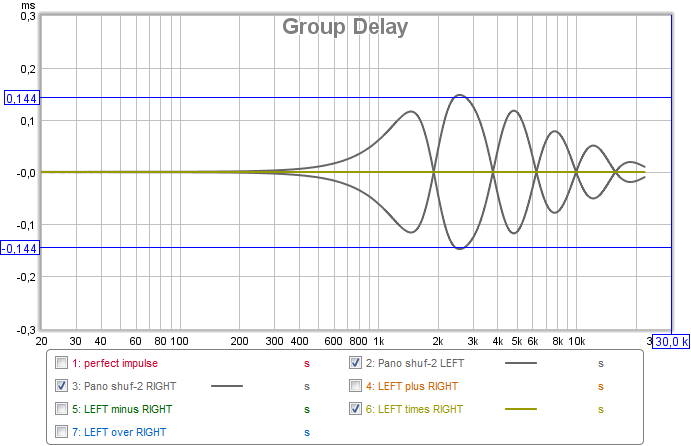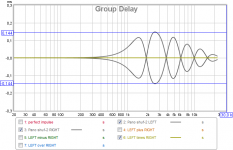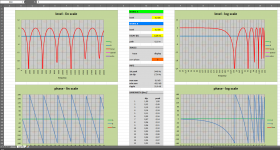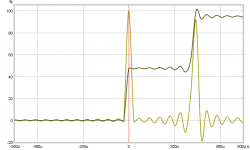My latest: http://www.diyaudio.com/forums/multi-way/277519-fixing-stereo-phantom-center-30.html#post4694674
wesayso's latest: http://www.diyaudio.com/forums/multi-way/277519-fixing-stereo-phantom-center-32.html#post4695429
Pano's original and now classic shuffle-2: http://www.diyaudio.com/forums/multi-way/277519-fixing-stereo-phantom-center-10.html#post4425656
Comparison samples of mine and Pano's: http://www.diyaudio.com/forums/multi-way/277519-fixing-stereo-phantom-center-31.html#post4694966
wesayso's latest: http://www.diyaudio.com/forums/multi-way/277519-fixing-stereo-phantom-center-32.html#post4695429
Pano's original and now classic shuffle-2: http://www.diyaudio.com/forums/multi-way/277519-fixing-stereo-phantom-center-10.html#post4425656
Comparison samples of mine and Pano's: http://www.diyaudio.com/forums/multi-way/277519-fixing-stereo-phantom-center-31.html#post4694966
Interesting stuff, guys. I've been reading along. Haven't had a chance to try anything yet. Pano, can you link to the latest files (post 280 was it?) from the first post? Would be easier to find the files. Thanks!
Oh nevermind I see what you mean. Yes I was thinkng that too, so others don't have to dig through the whole thread.
Hmm? Not sure I understand the question.
Scrap that question. I'm thinking (or at least trying to think) with a headache getting myself in loops.
The left channel signal will arrive at the left ear, some of it will arrive at the right ear at lower volume. That creates the dip at 2000 Hz if we go with a 0.27 ms delayed arrival of that left signal traveling to the right ear when it's combined with the first wave front from the right channel. It's the phase difference of 90 degrees (or 60 degrees in Pano's original shuffler) that makes that particular dip less deep. Vice versa for the other channel.
The group delay being in sync at 2000 Hz threw my line of thinking off for a bit, as the group delay difference is biggest at the phase nodes. It's not those phase nodes that influence the perceived signal. It's the out of phase content at 2000 Hz etc. that's causing the change. I can't think straight with this headache, so I won't try to make logic of what happens at the frequencies that have the biggest group delay difference, in other words, at the nodes of the phase plot.


Last edited:
wesayso,
Have you spottet some pattern or look for one to break the nut, sure you have done that before.
Is it so you want GD total shuffle correction to be flat +/-0,135mS to sum 0,27mS correction at all frq, that will need non flat phase correction in degrees. In below example two cursors is set close to that at ~0,28mS

Have you spottet some pattern or look for one to break the nut, sure you have done that before.
Is it so you want GD total shuffle correction to be flat +/-0,135mS to sum 0,27mS correction at all frq, that will need non flat phase correction in degrees. In below example two cursors is set close to that at ~0,28mS

Attachments
Last edited:
Nah, I was trying to think on a bad day. The thing of importance was the signals that have the biggest phase spread. While I was trying to figure out the influence of group delay and how that sums at one's ear. At the nodes where the phase difference is zero, there is now a group delay difference. No idea what that does for the perception or summation yet. I could find out, but not today  .
.
Last edited:
I could squeeze in a listening test of Pano's original Rephase Shuffle-2 and my own.
I'm undecided. Pano's effort still sounds good to me, natural. I could live with my own creation, I just can't call it a better attempt. I better start on another one sometime soon.
Don't have time for more testing, and it wasn't an ideal test as I'm pressed for time. Maybe I'll try BYRTT's suggestion but with all 30 degree phase swaps.
but with all 30 degree phase swaps.
I'm undecided. Pano's effort still sounds good to me, natural. I could live with my own creation, I just can't call it a better attempt. I better start on another one sometime soon.
Don't have time for more testing, and it wasn't an ideal test as I'm pressed for time. Maybe I'll try BYRTT's suggestion
These calculators from Merlijn Van Veen (Login is needed) https://www.merlijnvanveen.nl/en/ can show comb filter effect, below is spreadsheet "phase_V2.xlsx" and "delay_study_V1.2.xlsx".
Attachments
About comb filter forget traced frd file post 332, below attached 32bit IR-wavfile is much better and can be converted in REW to frd file. Created it in REW importing a perfect impulse twice from Rephase and delayed one of them 0,29mS before A plus B on "All SPL" tab.
Attachments
Last edited:
Thanks Byrtt, nice info.
But I have a question - why have we been using 0.29ms as the delay? Isn't that too short? The average male head is about 10cm wide and 15cm long. Shouldn't that mean a delay more like 0.44ms? Or is it the +/- 30 degree angle? Hmmmm. Think I just answered my own question.
But I have a question - why have we been using 0.29ms as the delay? Isn't that too short? The average male head is about 10cm wide and 15cm long. Shouldn't that mean a delay more like 0.44ms? Or is it the +/- 30 degree angle? Hmmmm. Think I just answered my own question.
If I am understanding how the shuffler is working from what everyone is writing and the graphs posted it seems you are altering the phase between the two sides with a varying phase pattern. If this is correct I am wondering why you couldn't hear this as some change between the left and right sides as some kind of tonal shift? Or am I just misinterpreting what you are doing and the phase shift is fixed just varied across the frequency band?
Hi,
i have long known, that stereo is problematic, unless strict recording and playback conditions are kept. Two seperate sources playing the same signal into a room must cause comb filtering at the listener, unless the listener's head is fixed at the exact center --in both dimensions!-- between both sources. The head fixed there, each ear only receives the treble signals from "its" source, while in the bass it does not matter. But in the usual same-sides-triangle stereo setups, there is too few spatial channel seperation, and comb filtering appears.
A solution is either-L-or-R-stereo, as used on early Beatles discs. Only the content below 200 Hz is on both channels. Just how would one accomplish either-L-or-R-stereo on live recordings, unless one uses multi-microphony? For a symphony orchestra?
Another solution is Kunstkopfstereophonie (artificial head stereophonics), which is best played back on headphones. The problem with headphones is, that we often unconsciously turn our head in order to scan our acoustical environment, and this movement is rendered useless, if the sources sit on our ears.
Stereo should have been introduced differently, more thot-tru and compatible, similar to the television b/w-to-colour conversion. One logical channel should be the main channel, while the other one should be the aux channel, which decides, on which physical channel the signal is played back, the main or aux one. Then, mono recordings lacking an aux channel, were always played back on only one source, the main source.
Uli
i have long known, that stereo is problematic, unless strict recording and playback conditions are kept. Two seperate sources playing the same signal into a room must cause comb filtering at the listener, unless the listener's head is fixed at the exact center --in both dimensions!-- between both sources. The head fixed there, each ear only receives the treble signals from "its" source, while in the bass it does not matter. But in the usual same-sides-triangle stereo setups, there is too few spatial channel seperation, and comb filtering appears.
A solution is either-L-or-R-stereo, as used on early Beatles discs. Only the content below 200 Hz is on both channels. Just how would one accomplish either-L-or-R-stereo on live recordings, unless one uses multi-microphony? For a symphony orchestra?
Another solution is Kunstkopfstereophonie (artificial head stereophonics), which is best played back on headphones. The problem with headphones is, that we often unconsciously turn our head in order to scan our acoustical environment, and this movement is rendered useless, if the sources sit on our ears.
Stereo should have been introduced differently, more thot-tru and compatible, similar to the television b/w-to-colour conversion. One logical channel should be the main channel, while the other one should be the aux channel, which decides, on which physical channel the signal is played back, the main or aux one. Then, mono recordings lacking an aux channel, were always played back on only one source, the main source.
Uli
Last edited:
Thanks Byrtt, nice info.
But I have a question - why have we been using 0.29ms as the delay? Isn't that too short? The average male head is about 10cm wide and 15cm long. Shouldn't that mean a delay more like 0.44ms? Or is it the +/- 30 degree angle? Hmmmm. Think I just answered my own question.
I calculated a 0.290 ms delay from a 2D sketch of my situation, but adjusted it to ~0.270 ms after listening tests with a pre-mixed signal. But as Mike said, it will probably be different in real life compared to the simulated plots due to things like head shading and room and even body influences.
If I am understanding how the shuffler is working from what everyone is writing and the graphs posted it seems you are altering the phase between the two sides with a varying phase pattern. If this is correct I am wondering why you couldn't hear this as some change between the left and right sides as some kind of tonal shift? Or am I just misinterpreting what you are doing and the phase shift is fixed just varied across the frequency band?
Only one way to find out Steven, setup your system to avoiding early reflections and give it a go
It will be interesting to see some real live measurements though, to fully understand what it achieves.
Yes, the ideal behind the phase shuffle is to fix the tonality of the center image. With the shuffler it should sound brighter, like a real speaker would in the same position. I.E., make the phantom center tonally the same as the left and right, or as a real center speaker.
So can I think that what is happening is that the comb filtering effect of the phantom center has moved to a new position between the center and the LR channels, won't there still have to be a point in space where the combination of LR still nulls? I assume you would have to move way off the center axis to notice this happen which isn't how we normally listen to music so wouldn't be an issue.
- Home
- Loudspeakers
- Multi-Way
- Fixing the Stereo Phantom Center






